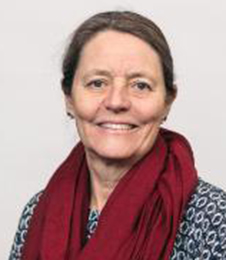Multilingualism as a Challenge and Resource
The number of children and young people in Denmark with an ethnic or linguistic minority background has more than quadrupled within the last 25 years. We therefore need to know more about this particular group's linguistic and cultural preconditions for taking part in education at primary/lower secondary school, youth education and university level.

Anne Holmen
At the Centre for Internationalisation and Parallel Language Use at the Faculty of Humanities, professor Anne Holmen and her colleagues are investigating how teaching can be improved and drop-out rates reduced by using pedagogical methods which take greater account of the pupils' and students' linguistic and cultural background.
The researchers use qualitative interviews to examine the need for special teaching initiatives for pupils and students from minority backgrounds, and how ordinary teaching can be arranged to better accommodate their learning needs.
Anne Holmen's research first of all gains knowledge of how to systematically map the need for Danish courses among children and young people from minority backgrounds. We now know, for example, that there is a need for courses in Danish as a second language, but that these must be academically oriented in terms of both content and structure. They must also have a name that, instead of stigmatising the course participants' needs, makes learning academic Danish a natural element of a study programme. This applies to minority-background students with Danish qualifying examinations, as well as international students and students with a Nordic background.
Secondly, research into Danish as a second language forms the basis for the general development of second-language pedagogical practice. The researchers contribute to the development of pedagogical practice concerning the link between the language of teaching and the individual subject area's academic content in schools or study programmes, e.g. mathematics, microbiology or media analysis.
Thirdly, the researchers' analyses reveal that taking pupils' and students' linguistic and cultural diversity as the starting point, holds potential that has yet to be utilised. Analyses of various pedagogical approaches in teaching show that there are serious shortcomings related to monocultural education. If the aim of education is to stimulate intellectual curiosity and sensitivity towards other ways of living, and to strengthen students' ability to assess arguments and form their own opinions, putting their linguistic and cultural resources into play is an obvious method to use. Bringing ethnic diversity into the classroom strengthens academic learning and minority-background pupils' personal identity. It also adds new dimensions to education and makes all pupils and students better prepared for our globalised society.
Impact
The Centre for Internationalisation and Parallel Language Use, which is approved as a language centre by the City of Copenhagen, holds targeted courses in Danish as a second language for knowledge workers and students in Greater Copenhagen, including employees of the University of Copenhagen. These courses contribute to improving the participants' integration and active contribution to the workplace, as well as in class, group work and networks at the University. For the students, this can reduce study-programme drop-out rates. Overall, this improves the graduates' academic performance, for the benefit of employers and Danish society in general. Furthermore, the improved degree of integration during their studies makes graduates more likely to choose to stay in Denmark after they graduate.
The Centre also holds specially designed Danish courses for engineers who come from abroad to work in Denmark. These courses help to retain valuable graduate manpower in the Danish labour market.
Anne Holmen's many activities outside the University include her courses in second-language pedagogical practice at the University of Greenland in Nuuk for teachers at a number of different educational institutions in Greenland. These courses give teachers tools to improve the students' written proficiency in their second language. This raises the standard of teaching and guidance in bilingual situations in Greenland in general and, all other things being equal, will reduce drop-out rates.
Further info
Den gode gartner og ukrudtet. Om minoritetselever i folkeskolens danskfag. (The good gardener and the weeds. About minority-background pupils in primary and lower secondary school Danish teaching. Haas, Claus et al.: Ret til dansk. Uddannelse, sprog og kulturarv. (Right to Danish. Education, language and cultural heritage.) Aarhus Universitetsforlag, 2011, 31-117
Sproglig diversitet blandt eleverne i grundskolen – fra problem til potentiale. (Linguistic diversity among primary and lower secondary school pupils – from problem to potential.)
In Gregersen, Annette et al. (eds.): Sprogfag i forandring, 2. rev. udgave, (Changes in language teaching, 2nd edited edition) 2015, 23-55
Linguistic Diversity among Students in Higher Education. A resource in a Multilingual Language Strategy. In Fabricius, Anne & Bent Preisler (eds.): Transcultural Interaction and Linguistic Diversity in Higher Education. The Student Experience. Palgrave, 2015, 116-142
Contact
Anne Holmen
Professor, Department of English, Germanic and Romance Studies
Director, Centre for Internationalisation and Parallel Language Use
aholmen@hum.ku.dk
Tel. no.: (+45) 35 32 81 74
